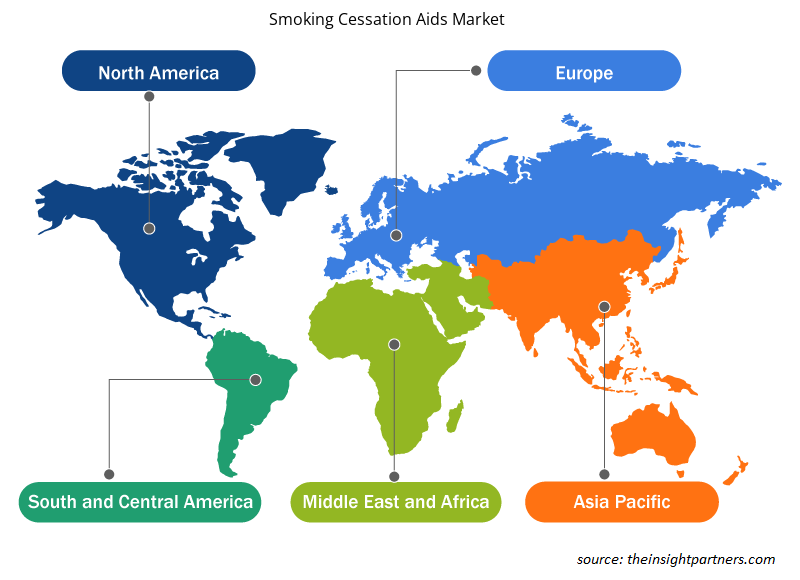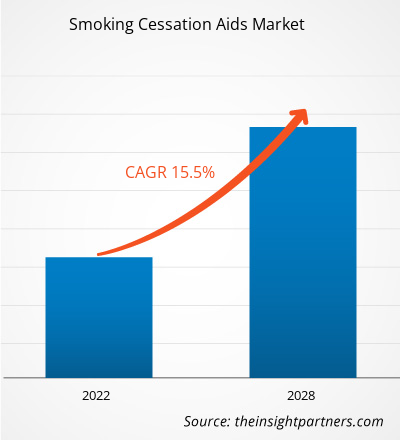Se espera que el mercado de productos para dejar de fumar alcance los 64.032,30 millones de dólares en 2028, frente a los 23.413,08 millones de dólares en 2021. Se estima que el mercado crecerá a una tasa compuesta anual del 15,5 % entre 2021 y 2028.
Los factores clave que impulsan el crecimiento de este mercado de ayudas para dejar de fumar son la creciente adicción al tabaco y el aumento del número de campañas para reducir el tabaquismo y la dependencia del tabaco. Sin embargo, es probable que el aumento de los costos para el desarrollo de terapias de reemplazo de nicotina limite en cierta medida el crecimiento del mercado en los próximos años.
Perspectivas del mercado
La creciente adicción al tabaco
La nicotina es una sustancia altamente adictiva que se encuentra en la planta del tabaco. Se ha demostrado que fumar tabaco es peligroso en todas sus formas, ya que puede provocar enfermedades crónicas, enfermedades prevenibles, muertes y discapacidades. Según la Organización Mundial de la Salud (OMS), los trastornos relacionados con el tabaquismo provocan alrededor de 435.000 muertes al año en los EE. UU., lo que equivale a alrededor de 1 de cada 5 del total de muertes en el país. Según los Centros para el Control y la Prevención de Enfermedades (CDC), en 2018, casi 40 millones de adultos en los EE. UU. fumaron cigarrillos. Además, alrededor de 4,7 millones de estudiantes de secundaria y preparatoria usaron al menos un producto de tabaco y alrededor de 1.600 jóvenes menores de 18 años en los EE. UU. fumaron sus primeros cigarrillos. Cada año, casi medio millón de pacientes mueren debido a enfermedades causadas por el tabaquismo. El gobierno de los EE. UU. gasta aproximadamente US$ 225 mil millones en atención médica para tratar a pacientes que padecen afecciones asociadas al tabaquismo en los EE. UU. Por lo tanto, la prevalencia del tabaquismo es alta en varios países del mundo.
Personalice este informe según sus necesidades
Obtendrá personalización en cualquier informe, sin cargo, incluidas partes de este informe o análisis a nivel de país, paquete de datos de Excel, así como también grandes ofertas y descuentos para empresas emergentes y universidades.
-
Obtenga las principales tendencias clave del mercado de este informe.Esta muestra GRATUITA incluirá análisis de datos, desde tendencias del mercado hasta estimaciones y pronósticos.
El escenario es similar en varios países europeos y asiáticos. Grecia, Bulgaria, Francia y Croacia comprenden las poblaciones de mayor consumo de tabaco en Europa. Según el Instituto de Métricas y Evaluación de la Salud, fumar es una adicción muy común en Europa, ya que más del 20% de los adultos mayores de 15 años fuman todos los días. Además, según el World Population Review, las tasas de tabaquismo más altas se encuentran en el sudeste asiático y los Balcanes en Europa. El WPR también sugiere que en varios países del sur y sudeste asiático, las tasas de tabaquismo tienden a ser altas entre los hombres. Por ejemplo, en Indonesia, la tasa de tabaquismo entre los hombres fue del 76,20% en 2018. Por lo tanto, el creciente número de poblaciones de fumadores en todo el mundo impulsa el crecimiento del mercado mundial de ayudas para dejar de fumar.
Perspectivas basadas en productos
Según el producto, el mercado de ayudas para dejar de fumar se segmenta en terapia de reemplazo de nicotina, medicamentos, cigarrillos electrónicos y otros. Los cigarrillos electrónicos se consideran una alternativa saludable a los cigarrillos de tabaco y se estima que será el segmento de más rápido crecimiento durante el período de pronóstico. Los cigarrillos electrónicos son una alternativa eficaz para reducir las condiciones de salud asociadas con el tabaco, mientras que las terapias de reemplazo de nicotina funcionan mejor para dejar de fumar. Los cigarrillos electrónicos son una amenaza potencial para los cigarrillos a base de tabaco. Además, el consumo de cigarrillos electrónicos es menos dañino en comparación con los cigarrillos normales, no produce humo y no hay riesgo de tabaquismo pasivo, se permite su uso incluso en lugares para no fumadores, los diferentes niveles de nicotina y la disponibilidad en varios sabores son algunos de los principales factores impulsores del mercado de cigarrillos electrónicos. Además, la creciente popularidad de los cigarrillos electrónicos respaldada por su característica electrónica es el factor principal que contribuye a su creciente demanda.
Información basada en el usuario final
Según el usuario final, el mercado de ayudas para dejar de fumar se segmenta en farmacias hospitalarias, canal en línea, farmacias minoristas y otros usuarios finales. Es probable que el segmento de farmacias minoristas tenga la mayor participación del mercado en 2021, sin embargo, se anticipa que el segmento del canal en línea registre la CAGR más alta del mercado durante el período de pronóstico.
Los actores clave como Pfizer Inc.; GlaxoSmithKline plc.; Dr. Reddy's Laboratories; Johnson and Johnson Services, Inc.; Cipla Inc.; Perrigo Company plc; Bausch Health Companies Inc.; Glenmark; NJOY; y Juul Labs adoptan varias estrategias orgánicas e inorgánicas para mejorar sus ingresos y posiciones en el mercado. Por ejemplo, en julio de 2020, Dr Reddy's Laboratories lanzó pastillas de venta libre de nicotina Polacrilex en el mercado estadounidense en concentraciones de 2 mg y 4 mg. Además, en noviembre de 2020, Perrigo Company plc completó el cuarto año de su campaña "Quitting is Better" en asociación con la Sociedad Estadounidense del Cáncer (ACS).
Perspectivas regionales del mercado de ayudas para dejar de fumar
Los analistas de Insight Partners han explicado detalladamente las tendencias y los factores regionales que influyen en el mercado de ayudas para dejar de fumar durante el período de pronóstico. Esta sección también analiza los segmentos y la geografía del mercado de ayudas para dejar de fumar en América del Norte, Europa, Asia Pacífico, Oriente Medio y África, y América del Sur y Central.

- Obtenga datos regionales específicos para el mercado de ayudas para dejar de fumar
Alcance del informe de mercado de ayudas para dejar de fumar
| Atributo del informe | Detalles |
|---|---|
| Tamaño del mercado en 2021 | US$ 23,41 mil millones |
| Tamaño del mercado en 2028 | US$ 64.03 mil millones |
| CAGR global (2021-2028) | 15,5% |
| Datos históricos | 2019-2020 |
| Período de pronóstico | 2022-2028 |
| Segmentos cubiertos |
Por producto
|
| Regiones y países cubiertos |
América del norte
|
| Líderes del mercado y perfiles de empresas clave |
|
Densidad de actores del mercado de ayudas para dejar de fumar: comprensión de su impacto en la dinámica empresarial
El mercado de productos para dejar de fumar está creciendo rápidamente, impulsado por la creciente demanda de los usuarios finales debido a factores como la evolución de las preferencias de los consumidores, los avances tecnológicos y una mayor conciencia de los beneficios del producto. A medida que aumenta la demanda, las empresas amplían sus ofertas, innovan para satisfacer las necesidades de los consumidores y aprovechan las tendencias emergentes, lo que impulsa aún más el crecimiento del mercado.
La densidad de actores del mercado se refiere a la distribución de las empresas o firmas que operan dentro de un mercado o industria en particular. Indica cuántos competidores (actores del mercado) están presentes en un espacio de mercado determinado en relación con su tamaño o valor total de mercado.
Las principales empresas que operan en el mercado de ayudas para dejar de fumar son:
- Pfizer Inc.
- Compañía: GlaxoSmithKline plc.
- Laboratorios del Dr. Reddy
- Servicios Johnson y Johnson, Inc.
- Compañía Cipla Inc.
Descargo de responsabilidad : Las empresas enumeradas anteriormente no están clasificadas en ningún orden particular.

- Obtenga una descripción general de los principales actores clave del mercado de ayudas para dejar de fumar
Mercado de ayudas para dejar de fumar (por producto)
- Terapia de reemplazo de nicotina
- Drogas
- Cigarrillos electrónicos
- Otros
Mercado de ayudas para dejar de fumar: por usuario final
- Farmacias hospitalarias
- Canal en línea
- Farmacias minoristas
- Otros
Mercado de ayudas para dejar de fumar por geografía
-
América del norte
- A NOSOTROS
- Canadá
- México
-
Europa
- Francia
- Alemania
- Italia
- Reino Unido
- España
- Resto de Europa
-
Asia Pacífico (APAC)
- Porcelana
- India
- Japón
- Australia
- Corea del Sur
- Resto de Asia Pacífico
-
Oriente Medio y África (MEA)
- Sudáfrica
- Arabia Saudita
- Emiratos Árabes Unidos
- Resto de Oriente Medio y África
-
América del Sur y Central (SCAM)
- Brasil
- Argentina
- Resto de América del Sur y Central
Perfiles de empresas
- Pfizer Inc.
- Compañía: GlaxoSmithKline plc.
- Laboratorios del Dr. Reddy
- Servicios Johnson y Johnson, Inc.
- Compañía Cipla Inc.
- Compañía Perrigo plc
- Empresas de salud Bausch Inc.
- Marca Glen
- NJOY
- Laboratorios Juul
- Análisis histórico (2 años), año base, pronóstico (7 años) con CAGR
- Análisis PEST y FODA
- Tamaño del mercado, valor/volumen: global, regional y nacional
- Industria y panorama competitivo
- Conjunto de datos de Excel
Informes recientes
Testimonios
Razón para comprar
- Toma de decisiones informada
- Comprensión de la dinámica del mercado
- Análisis competitivo
- Información sobre clientes
- Pronósticos del mercado
- Mitigación de riesgos
- Planificación estratégica
- Justificación de la inversión
- Identificación de mercados emergentes
- Mejora de las estrategias de marketing
- Impulso de la eficiencia operativa
- Alineación con las tendencias regulatorias























 Obtenga una muestra gratuita para - Mercado de ayudas para dejar de fumar
Obtenga una muestra gratuita para - Mercado de ayudas para dejar de fumar